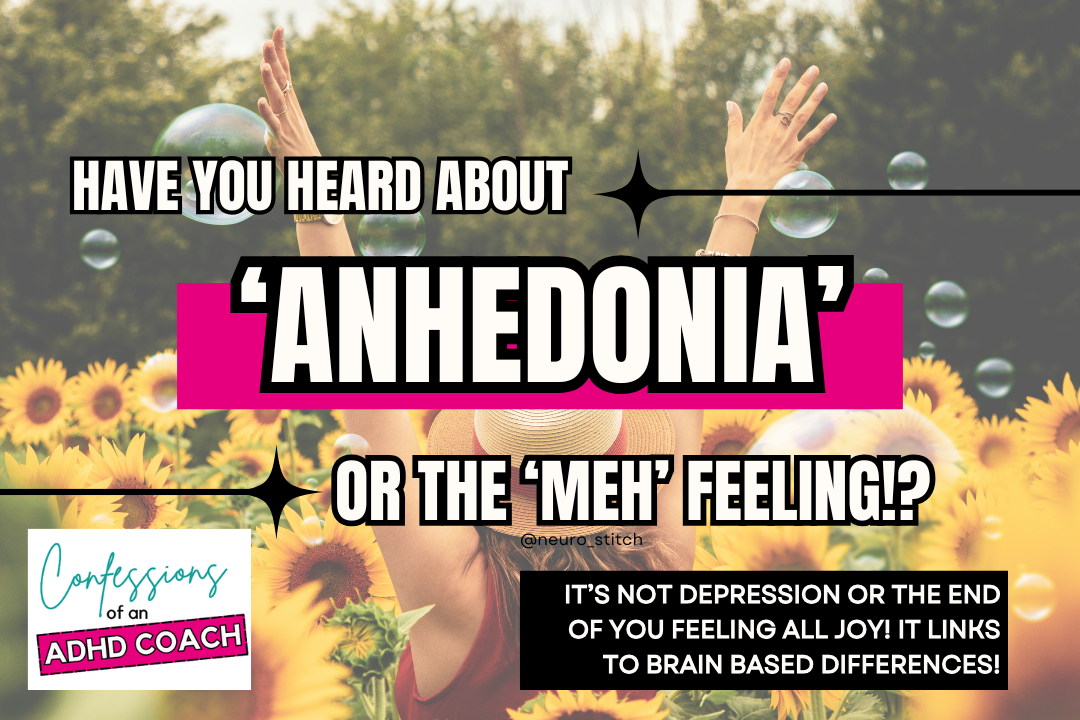
Anhedonia, ADHD & Autism — When “Feeling Meh” Is More Than Just a Mood
🧠✨ Anhedonia, ADHD & Autism — When “Feeling Meh” Is More Than Just a Mood
You know that “meh” feeling? When everything looks fine from the outside — maybe even great — but inside you just feel... empty. Like someone turned down the volume on joy. 😶
It’s that strange disconnect where you want to feel happy, but can’t quite get there. And honestly, it’s one of the most confusing, frustrating experiences for neurodivergent brains.
Recently, Selena Gomez mentioned this feeling in a podcast chat with Amy Poheler (Good Hang) — she said sometimes she just can’t enjoy things, even when she knows she should. That right there? That’s called Anhedonia.
🩵 So… what actually is Anhedonia?
It’s an old medical term that basically means: difficulty feeling pleasure or joy from things that used to make you happy.
It’s not depression, though it can show up alongside it. It’s not laziness, ungratefulness, or “not trying hard enough.” It’s often your brain saying, “I’m overwhelmed, under-fuelled, or just out of emotional bandwidth.”
And while anyone can experience it, it’s incredibly common in ADHD and Autistic individuals.
🧩 The Neurodivergent Twist:
Here’s the thing — when you’ve got an ADHD or AuDHD brain, you already work with about 30% less executive functioning capacity than neurotypical folks.
That means it takes way more effort to do things, feel things, and even process things.
Sometimes, what looks like “not feeling joy” is actually a delay in emotional processing.
It’s not that the feelings aren’t there — they just haven’t caught up yet. Like your heart and brain are buffering. ⏳
⚡ The Dopamine Dilemma
Dopamine — that little chemical behind motivation, pleasure, and reward — doesn’t flow the same way in ADHD or Autistic brains.
So when dopamine levels dip or receptors don’t quite respond properly, your reward system goes a bit offline. Suddenly, even the things that usually light you up — hobbies, social time, a win at work — just don’t hit like they used to.
Your sparkle feels dimmed, and everything starts to feel like “going through the motions.”
😞 What it can look like:
- Feeling emotionally flat or disconnected
- Struggling to feel excitement, even for good news
- Crying without knowing why, or not being able to cry at all
- Feeling empty or “hollow” on the inside
- Going through the motions but feeling detached
- Questioning why you can’t just “be happy” like everyone else
💥 Why it happens
There’s a mix of things going on under the hood:
- Delayed emotional processing (your body’s lagging behind your mind)
- Chronic stress or burnout — that “too tired to feel” zone
- Executive dysfunction — the brain fog that kills motivation
- Poor dopamine reception — when rewards don’t feel rewarding
- Autistic fatigue or shutdown — emotional overload and withdrawal
- Rejection Sensitivity Dysphoria (RSD) — feeling unworthy or like you’ve failed
When all that layers up, your brain does what it thinks will protect you: it numbs out.
It’s like your internal smoke alarm going off so often that it shuts itself down just to cope.
💫 Finding small sparks again
Here’s the thing: there is hope. There is healing.
But it’s another one of those life lessons no one teaches us about — especially not when you grow up masking, people-pleasing, or fighting to “fit in.”
Healing Anhedonia isn’t about forcing joy or faking positivity. It’s about finding small sparks of contentment, even when life feels muted.
Start small:
💙 Stroking your snoozy pup’s fur (hi, Sooty 🐾)
💙 That first sip of coffee in the quiet
💙 Sunlight on your face after days of rain
💙 Wearing your favourite turquoise ring because it feels good
💙 Rewatching a comfort show without guilt
You’re not broken, and don't need to be 'Fixed'. You’re buffering. Your system’s just asking for gentleness, space, and time to reboot.
🕊️ The Reframe
Anhedonia doesn’t mean you’re failing at life or missing something everyone else has.
It’s your brain protecting you in its own way — conserving energy, regulating emotions, and saying: “Hey, I’m tired. Let’s take a pause.”
The goal isn’t to rush the joy back. It’s to give yourself permission to go slower, notice the small moments, and let the feelings catch up.
And when they do — they’ll feel real, grounded, and safe.
Because you’ll know you created space for them to come back on their own terms. 💛 You've Got This!
